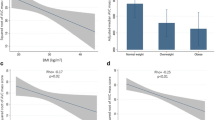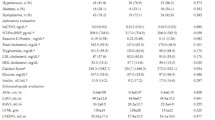Abstract
Aortic sclerosis is associated with increased cardiovascular mortality and morbidity. Numerous studies have shown that visceral adiposity is associated with development of atherosclerosis, especially in the adjacent vascular wall. Considering the similar pathophysiology of aortic sclerosis and atherosclerosis, it can be hypothesized that visceral adipose tissue adjacent to aortic valve may be associated with aortic sclerosis. In this study, we investigated the relationship between periaortic adipose tissue volume and sclerotic changes in the adjacent aortic valve. In this retrospective study, 80 patients with a concurrent MSCT and echocardiography in the last 6 months were enrolled. Echocardiographic examinations were retrospectively evaluated regarding the presence of aortic sclerosis. Periaortic adipose tissue volume was calculated on a computer assisted work station (Leonardo Workstation, Siemens, Erlangen, Germany) by an experienced radiologist. Patient group (61.63 ± 8.55 years and 50% male) and the control group (61.45 ± 5.68 years, 50% male) each consisted 40 participants. Patient group had significantly higher BUN (42.50 (15.00−211.00) vs. 34.00 (12.00−107.00) mg/dL, p = 0.003), uric acid (5.40 (3.40−14.70) vs. 4.30 (2.30−6.70) ng/mL, p = 0.005) and LDL-C levels (121.50 (60.00−215.00) vs. 86.50 (49.00−209.00) mg/dL, p = 0.001) when compared to control group. Patient group had also significantly higher periaortic adipose tissue volume (32.45 (11.70−51.23) vs. 16.00 (6.29−32.96) ml, p < 0.001). Multivariate regression analysis revealed that periaortic adipose tissue volume was independently associated with the presence of aortic sclerosis (OR 0.241, 95% CI 0.143–0.946, p = 0.001). In this study, we demonstrated for the first time that periaortic adipose tissue volume was independently associated with the presence of sclerotic changes in the adjacent aortic valve.


Similar content being viewed by others

References
Grundy SM, Brewer HB Jr, Cleeman JI, Smith SC Jr, Lenfant C, National Heart, Lung, and Blood Institute/American Heart Association (2004) Definition of metabolic syndrome: report of the National Heart, Lung, and Blood Institute/American Heart Association conference on scientific issues related to definition. Arterioscler Thromb Vasc Biol 24(2):e13-18. https://doi.org/10.1161/01.ATV.0000111245.75752.C6
Carr DB, Utzschneider KM, Hull RL, Kodama K, Retzlaff BM, Brunzell JD, Shofer JB, Fish BE, Knopp RH, Kahn SE (2004) Intra-abdominal fat is a major determinant of the National Cholesterol Education Program Adult Treatment Panel III criteria for the metabolic syndrome. Diabetes 53(8):2087–2094. https://doi.org/10.2337/diabetes.53.8.2087
Kershaw EE, Flier JS (2004) Adipose tissue as an endocrine organ. J Clin Endocrinol Metab 89(6):2548–2556. https://doi.org/10.1210/jc.2004-0395
Sharma AM (2004) Mediastinal fat, insulin resistance, and hypertension. Hypertension 44(2):117–118. https://doi.org/10.1161/01.HYP.0000137993.70745.82
Stewart BF, Siscovick D, Lind BK, Gardin JM, Gottdiener JS, Smith VE, Kitzman DW, Otto CM (1997) Clinical factors associated with calcific aortic valve disease. Cardiovascular Health Study. J Am Coll Cardiol 29(3):630–634. https://doi.org/10.1016/s0735-1097(96)00563-3
Lindroos M, Kupari M, Heikkila J, Tilvis R (1993) Prevalence of aortic valve abnormalities in the elderly: an echocardiographic study of a random population sample. J Am Coll Cardiol 21(5):1220–1225. https://doi.org/10.1016/0735-1097(93)90249-z
Otto CM, Lind BK, Kitzman DW, Gersh BJ, Siscovick DS (1999) Association of aortic-valve sclerosis with cardiovascular mortality and morbidity in the elderly. N Engl J Med 341(3):142–147. https://doi.org/10.1056/NEJM199907153410302
Aronow WS, Schwartz KS, Koenigsberg M (1987) Correlation of serum lipids, calcium, and phosphorus, diabetes mellitus and history of systemic hypertension with presence or absence of calcified or thickened aortic cusps or root in elderly patients. Am J Cardiol 59(9):998–999. https://doi.org/10.1016/0002-9149(87)91144-1
Prasad Y, Bhalodkar NC (2004) Aortic sclerosis: a marker of coronary atherosclerosis. Clin Cardiol 27(12):671–673. https://doi.org/10.1002/clc.4960271202
Chistiakov DA, Grechko AV, Myasoedova VA, Melnichenko AA, Orekhov AN (2017) Impact of the cardiovascular system-associated adipose tissue on atherosclerotic pathology. Atherosclerosis 263:361–368. https://doi.org/10.1016/j.atherosclerosis.2017.06.017
Baumgartner HC, Hung JC-C, Bermejo J, Chambers JB, Edvardsen T, Goldstein S, Lancellotti P, LeFevre M, Miller F Jr, Otto CM (2017) Recommendations on the echocardiographic assessment of aortic valve stenosis: a focused update from the European Association of Cardiovascular Imaging and the American Society of Echocardiography. Eur Heart J Cardiovasc Imaging 18(3):254–275. https://doi.org/10.1093/ehjci/jew335
Ronti T, Lupattelli G, Mannarino E (2006) The endocrine function of adipose tissue: an update. Clin Endocrinol 64(4):355–365. https://doi.org/10.1111/j.1365-2265.2006.02474.x
Hamdy O, Porramatikul S, Al-Ozairi E (2006) Metabolic obesity: the paradox between visceral and subcutaneous fat. Curr Diabetes Rev 2(4):367–373
Rodriguez A, Catalan V, Gomez-Ambrosi J, Fruhbeck G (2007) Visceral and subcutaneous adiposity: are both potential therapeutic targets for tackling the metabolic syndrome? Curr Pharm Des 13(21):2169–2175. https://doi.org/10.2174/138161207781039599
Hitsumoto T, Takahashi M, Iizuka T, Shirai K (2007) Relationship between metabolic syndrome and early stage coronary atherosclerosis. J Atheroscler Thromb 14(6):294–302. https://doi.org/10.5551/jat.e506
Carbone F, Mach F, Montecucco F (2015) The role of adipocytokines in atherogenesis and atheroprogression. Curr Drug Targets 16(4):295–320. https://doi.org/10.2174/1389450115666141109213439
Venteclef N, Guglielmi V, Balse E, Gaborit B, Cotillard A, Atassi F, Amour J, Leprince P, Dutour A, Clement K, Hatem SN (2015) Human epicardial adipose tissue induces fibrosis of the atrial myocardium through the secretion of adipo-fibrokines. Eur Heart J 36(13):795–805a. https://doi.org/10.1093/eurheartj/eht099
Oikawa M, Owada T, Yamauchi H, Misaka T, Machii H, Yamaki T, Sugimoto K, Kunii H, Nakazato K, Suzuki H, Saitoh S, Takeishi Y (2016) Predominance of abdominal visceral adipose tissue reflects the presence of aortic valve calcification. Biomed Res Int 2016:2174657. https://doi.org/10.1155/2016/2174657
Mahabadi AA, Kahlert HA, Dykun I, Balcer B, Kahlert P, Rassaf T (2017) Epicardial adipose tissue thickness independently predicts severe aortic valve stenosis. J Heart Valve Dis 26(3):262–267
Genctoy G, Eldem O, Ergun T, Arikan S (2015) Periaortic fat tissue: a predictor of cardiac valvular calcification, malnutrition, inflammation, and atherosclerosis components in hemodialysis patients. Artif Organs 39(9):748–755. https://doi.org/10.1111/aor.12463
Demir B, Caglar IM, Ugurlucan M, Ozde C, Tureli HO, Cifci S, Vural A, Karakaya O (2012) The relationship between severity of calcific aortic stenosis and serum uric acid levels. Angiology 63(8):603–608. https://doi.org/10.1177/0003319711433198
Kimura Y, Yanagida T, Onda A, Tsukui D, Hosoyamada M, Kono H (2020) Soluble uric acid promotes atherosclerosis via AMPK (AMP-activated protein kinase)-mediated inflammation. Arterioscler Thromb Vasc Biol 40(3):570–582. https://doi.org/10.1161/ATVBAHA.119.313224
Karabag Y, Rencuzogullari I, Cagdas M, Karakoyun S, Yesin M, Atalay E, Cagdas OS, Gursoy MO, Burak C, Tanboga HI (2019) Association of serum uric acid levels with SYNTAX score II and long term mortality in the patients with stable angina pectoris who undergo percutaneous coronary interventions due to multivessel and/or unprotected left main disease. Int J Cardiovasc Imaging 35(1):1–7. https://doi.org/10.1007/s10554-018-1446-6
Kazory A (2010) Emergence of blood urea nitrogen as a biomarker of neurohormonal activation in heart failure. Am J Cardiol 106(5):694–700. https://doi.org/10.1016/j.amjcard.2010.04.024
Gary T, Pichler M, Schilcher G, Hafner F, Hackl G, Rief P, Eller P, Brodmann M (2015) Elevated blood urea nitrogen is associated with critical limb ischemia in peripheral arterial disease patients. Medicine 94(24):e948. https://doi.org/10.1097/MD.0000000000000948
Funding
This project was funded by University of Health Sciences Educational Planning Commission.
Author information
Authors and Affiliations
Corresponding author
Ethics declarations
Conflict of interest
The authors declare that there is no conflict of interest.
Additional information
Publisher's Note
Springer Nature remains neutral with regard to jurisdictional claims in published maps and institutional affiliations.
Rights and permissions
About this article
Cite this article
Mustu, M., Gurses, K.M., Alpaydin, M.S. et al. Periaortic adipose tissue volume is associated with sclerotic changes in the adjacent aortic valve. Int J Cardiovasc Imaging 36, 1559–1565 (2020). https://doi.org/10.1007/s10554-020-01852-2
Received:
Accepted:
Published:
Issue Date:
DOI: https://doi.org/10.1007/s10554-020-01852-2



